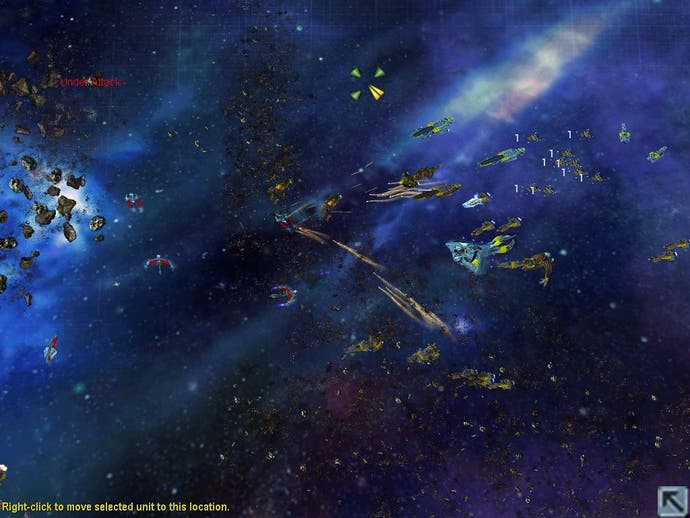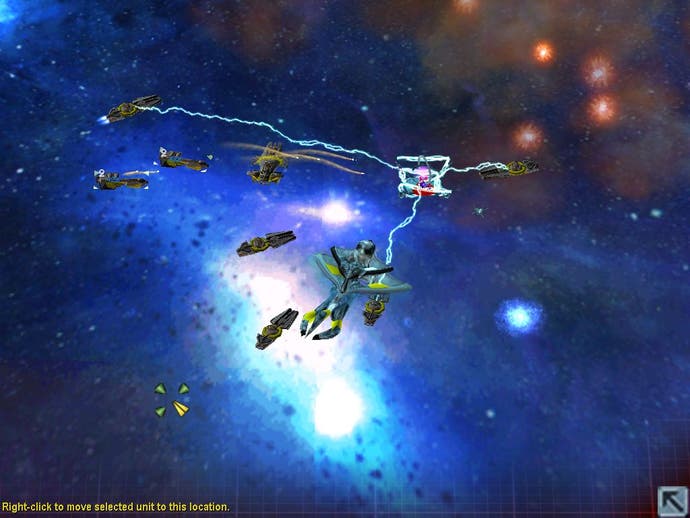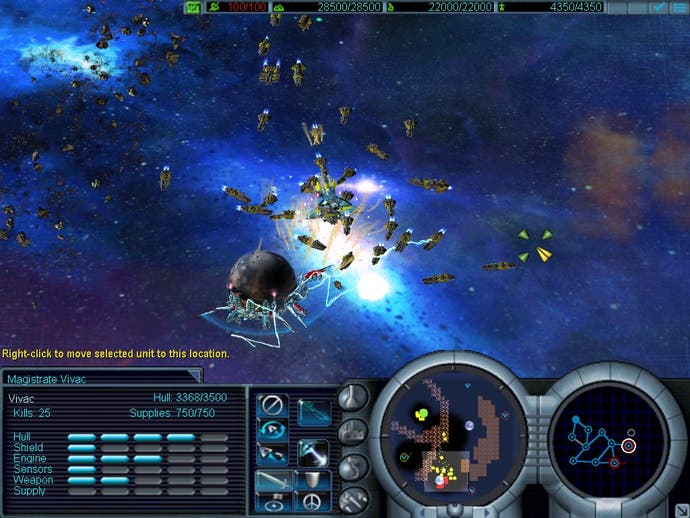Conquest : Frontier Wars
Review - the real-time strategy genre takes on the final frontier

Another Bug Hunt
As Conquest begins, humanity is taking its first faltering steps amongst the stars thanks to the discovery of jump gate technology, but this being a real-time strategy game you just know that things aren't going to go smoothly. Sure enough, a Terran ship strays into the middle of a civil war and gets run over by a big honking alien battleship in pursuit of a rebel leader, at which point all hell breaks loose. You are sent to find out what happened to the missing ship, but before you know it your simple rescue mission has turned into a five way war between humanity and rival factions from two alien races. Unlike most real-time strategy games Conquest takes place in space rather than on the ground, although in contrast to Homeworld and FarGate it sticks resolutely to two dimensions and a traditional overhead view of the action. This is a little disappointing at first, but it does make the game easier to get to grips with and means that you can focus on actual strategy instead of struggling with rotating camera views. The other problem with space is that it is, by definition, big and empty. Conquest solves this by restricting the game to relatively small circular maps linked by wormholes which act as chokepoints. Initially you only have two or three solar systems to worry about, but the further into the game you get the more maps you will have to fight over. By the end of the campaign battles may rage across a dozen systems, interlinked by a maze of wormholes.

Spaced Out
Space is somewhat more interesting in Conquest than real life, with nebulae, asteroid fields, planets and impassable anti-matter ribbons scattered across the maps. These are intended to replace the hills and rivers found in ground-based strategy games, but don't do the job very well. Asteroid fields slow down ships as they navigate the area, while nebulae come in a variety of colours, each with its own effects. These range from slowing down or speeding up movement to interfering with shields or increasing the damage taken from weapons fire, but in most cases the effects are too slight to have any noticeable effect on the game. Stationing ships in a red nebula which gradually eats away at their hulls is obviously not a good idea, but it takes so long for the gas to cause any serious amount of damage that simply passing through a patch doesn't really hurt you. The AI doesn't seem to understand the effects of the nebulae either, quite happily wandering into a blue shield-depleting gas cloud in the middle of a battle or trying to cross a system by travelling through a vast green nebula that slows them down. This is particularly clear in the pathfinding of your own units, which always take the shortest route instead of the quickest or safest, ignoring any nebulae or asteroid fields completely.

Fixing A Hole
The ineffectiveness of the "terrain" blows the game wide open. Apart from the rare anti-matter barriers the only real bottlenecks which you can defend are the wormholes, and so battles tend to focus around these. Once the enemy gets into one of your systems it's hard to do anything about it apart from chasing them futilely around the map while desperately trying to plug the hole and stop any more units from getting in. If the enemy does break through into your territory, they will probably make a bee-line for the nearest planet. Planets are the only place you can build base structures, and depending on their class they can also provide some or all of the game's three resources once the appropriate buildings are in place. Everything from unit production facilities and resource gathering refineries to a wide range of specialized research labs can be built around the planets, although there is limited space on each. This forces you to keep expanding, seeking out strange new worlds to pillage and turn into ad hoc military camps. Planets also act as forward supply bases, because in Conquest your ships actually consume ammunition. It usually takes a few minutes for them to run out, but once they do they are helpless until they come within range of a supply base or ship. These support ships must dock with a base to restock eventually, and supply and repair bases only work if there are friendly jump gates linking the map they are in to your home system. This means that you can greatly weaken the enemy by knocking out his supply lines, which makes defending wormholes even more important. A few ships can take out a supply base or jump gate if they can get past your fleet, and there's not much you can do to stop them.

Far And Wide
It doesn't help that you have a limited fleet at your disposal. Throughout the campaign you can only have a maximum of one hundred command points worth of ships under your control, and every combat ship uses up at least two of these. Throw in a few support vessels, miners and construction ships and you can have perhaps thirty or forty warships. While this makes for more tactical battles and averts the tank rushing seen in most real-time strategy games, it does mean that your forces are spread fairly thin. You simply can't spare enough ships to defend your bases and jump gates if you are trying to hold down a couple of wormholes and invade an enemy sector. The multiplayer and quick battle modes do allow you to increase the command point cap to two hundred, but even this is fairly low if you are fighting up to seven AI or human opponents across sixteen systems. Luckily you can split up into teams if you want to have a more epic battle, and the addition of hero characters allows you to delegate control of fleets to the computer, leaving a group of ships to mop up stragglers with a "seek and destroy" command while you focus on another part of the conflict. Bizarrely in the main campaign this isn't possible though, and heroes simply exist to get themselves killed, leading to a game over screen and much frustration. The AI needs all the help it can get though. It does a solid job in the single player campaign thanks to having a stronger starting position than you in most of the fifteen missions, but when faced with a level playing field it tends to be a bit of a push-over. It's telling that changing the difficulty level in quick battle mode simply changes the number of enemy leaders that are ganged up against you. After four years in development then, Conquest is a bit of a mixed bag. The supply system adds a new dimension to the game, but because the nebulae and asteroid fields aren't effective enough to be worth avoiding the game becomes a series of do-or-die battles over jump gates. While this is entertaining enough for a while, you can't help but think that it could have been much more involving.
-
The Death Of The Celebrity Studio

